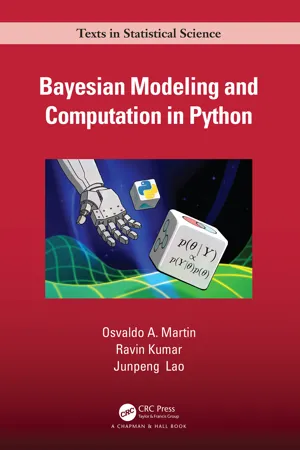
Bayesian Modeling and Computation in Python
Osvaldo A. Martin, Ravin Kumar, Junpeng Lao
- 398 pagine
- English
- ePUB (disponibile sull'app)
- Disponibile su iOS e Android
Bayesian Modeling and Computation in Python
Osvaldo A. Martin, Ravin Kumar, Junpeng Lao
Informazioni sul libro
Bayesian Modeling and Computation in Python aims to help beginner Bayesian practitioners to become intermediate modelers. It uses a hands on approach with PyMC3, Tensorflow Probability, ArviZ and other libraries focusing on the practice of applied statistics with references to the underlying mathematical theory.
The book starts with a refresher of the Bayesian Inference concepts. The second chapter introduces modern methods for Exploratory Analysis of Bayesian Models. With an understanding of these two fundamentals the subsequent chapters talk through various models including linear regressions, splines, time series, Bayesian additive regression trees. The final chapters include Approximate Bayesian Computation, end to end case studies showing how to apply Bayesian modelling in different settings, and a chapter about the internals of probabilistic programming languages. Finally the last chapter serves as a reference for the rest of the book by getting closer into mathematical aspects or by extending the discussion of certain topics.
This book is written by contributors of PyMC3, ArviZ, Bambi, and Tensorflow Probability among other libraries.
Domande frequenti
Informazioni
1 Bayesian Inference
1.1 Bayesian Modeling
1.1.1 Bayesian Models
- Unknown quantities are described using probability distributions 1. We call these quantities parameters 2.
- Bayes’ theorem is used to update the values of the parameters conditioned on the data. We can also see this process as a reallocation of probabilities.